The Trust offers financial assistance to individuals or groups to carry through restoration or improvement projects to completion. The Trust also invites enquiries about sponsoring one or more Awards.

National Transport Trust Commemorative Awards
With the exception of the Sir William McAlpine Award, projects winning a National Transport Trust Commemorative Award are selected from those already awarded Restoration Awards each year, and as such, are recognised as the best of the best of each year's restoration projects receiving a commemorative certificate in addition to the Restoration Award itself.
The Sir William McAlpine Award
The Sir William McAlpine Award commemorates the great preservationist and transport heritage enthusiast and former National Transport Trust president. The winner is selected by Sir William's widow and current President of the National Transport Trust, Judy, Lady McAlpine.
The David Muirhead Award
David Muirhead was an officer of the Trust in its early days and was exclusively a rail enthusiast; the David Muirhead Award therefore is made to a railway restoration project.
This year both the Sir William McAlpine and the David Muirhead awards have been presented to:
Stephen Middleton - 1877 Great Eastern Railway Prince of Wales Saloon
Owned and restored by Stephen Middleton, of Harrogate, this project has involved the painstaking restoration of a teak, six wheel carriage converted for the use of the Prince of Wales and having several unique features. The carriage was converted from a private saloon for use by Edward, Prince of Wales, in 1881, reverting to a private saloon in 1892. The coach is one of the few remaining royals, with most other royal vehicles, outside the current royal train, having either been converted back to passenger stock, departmental use or static exhibits, many in the National Railway Museum or its Shildon outpost.
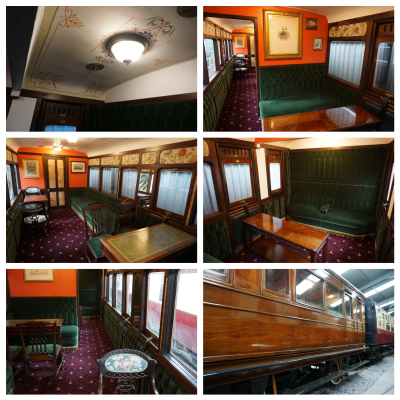
The amount of work on this restoration thus far has been considerable, and it has been executed by Stephen, his family, and a small team, to very high quality. All the fittings are period, and these, together with the finishes, are either original or a close replica. The ceiling in the end compartment is a replica of the painted linen original, copied in meticulous detail. That said, the work continues, as the furniture goes in, There are brakes, a heating system and new wheel bearings to fit, a kitchen and heating to install as well as more varnish, gold leaf and crests to apply. This is a high quality restoration of an unusual vehicle. Visitors will be able to travel on it, enjoy fine food and really feel as the Prince of Wales must have done. Although Stephen's team is small, they crack on and achieve magnificent standards. They thoroughly deserve this restoration award.

The President's Award
The President's award is made to individuals at the discretion of the National Transport Trust President Judy, Lady McAlpine. This year there are two winners:
Jack Dibnah
In 2020, Jack Dibnah, son of the late Fred Dibnah MBE, the famous Bolton steeplejack and TV personality, acquired the Kerr Stuart 0-4-0ST Witch class locomotive, works number 4388, with a view to restoring it to full working order. The locomotive was built in 1926 to an unusual design with outside valve gear and a very small saddle tank. It was built to shunt coal wagons for the British Gas Light Company's works in Stoke-on-Trent. It arrived at the Foxfield Heritage Railway in 1983 where it was restored to steam, and ran until 1999, after which it was stored pending an overhaul. The loco was acquired by Jack Dibnah in 2020, and was in a decrepit state requiring major restoration work.
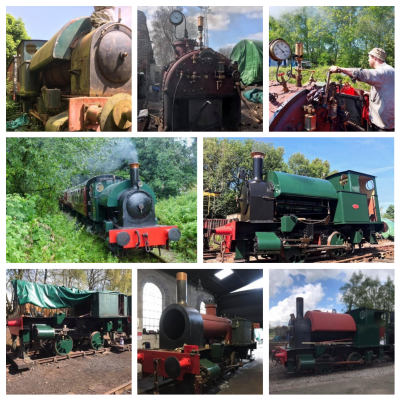
Its overhaul and rebuild has seen a lot of work carried out which has included the fitment of a new saddle tank. A major milestone was reached in June 2022 when it was steamed in one piece for the first time since 1999, and restoration work continued delivering the completed locomotive as it can be seen today, and in recognition of this work, Jack has been presented with Lady McAlpine's special recognition award.
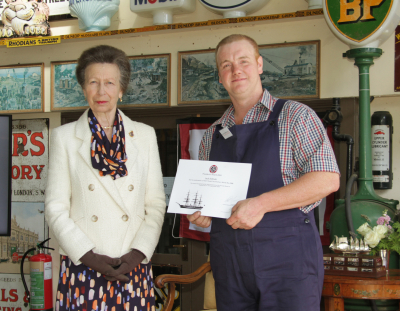
Malcolm Stern
In the second half of the 1930s, a Mr Stern owned a rather dashing Talbot Darracq. He was in the motor trade in the 1930s and, typically for someone in the business, he hung on to cars that took his fancy and used them for his family transport. It was probably about 5 or 6 years old when he bought it, having been built in 1930. His son really liked this car and has pictures of himself aged about 8 with it. It was sold in 1941 and nothing more was heard of it for 60 years. When the former 8 year old saw it was for sale, prompted by his happy memories of the car, he eagerly went to see it, but to his disappointment it was in such a dreadful condition that he walked away. In 2018 it was listed in a Bonham's auction. Mr Stern's grandson, who lives in the U.S.A., tried to bid for it, but due to communication glitches the auction had ended before he could make a bid. However, the car had not reached its reserve and was unsold, and some telephone negotiations secured the car. Some work had been done since 2001, but it was still incomplete with many parts in boxes. All this happened at the beginning of the COVID pandemic, so the new owner was able to stave off the boredom of the lockdowns and use his engineering skills and ingenuity to complete the restoration, with the help of Tim Walker Restorations.
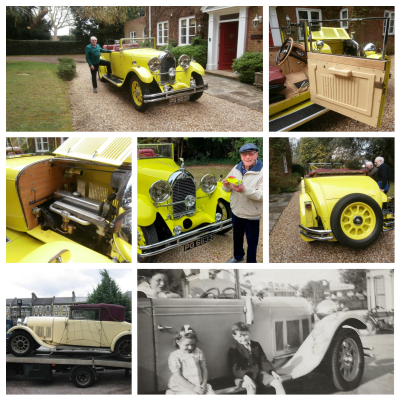
The former 8 year old, now in his 90s, made many parts himself, using his newly acquired skills with his 3D printer to make patterns which were sent off to be reproduced in metal. Although the car has passed its MOT and is usable, much work still needs to be done - it still has no hood for instance. It has not been restored to original condition or to win prizes; it has been restored for the joy of driving the car. The restorer remembers his father driving him around in it as a boy, and is able to pass it on to his children and grandchildren as a piece of living family history. Our awards panel was very drawn to the family story attached to the car and the enterprise and ambition of starting a restoration project within sight of one's centenary.
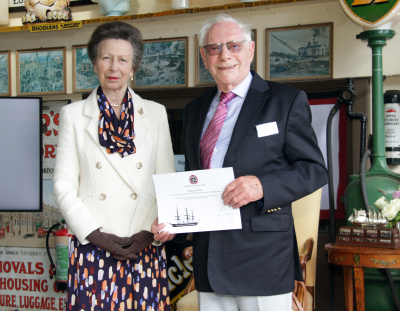
The Ron Wilsdon Award
The Ron Wilsdon Award is made in memory of one of the National Transport Trust's founders. His transport heritage interest was primarily cars and road vehicles, so this award generally goes to an award winning restoration of a road vehicle. This year, the Ron Wilsdon Award is made to:![]()
Steve Rodd - 1934 Guy Wolf Flatbed Lorry
Owned and being restored by Steve Rodd of Wincanton in Somerset, this is an interesting little lorry from another long lost British manufacturer. Originally rescued and restored by the current owner's father, but time has taken its toll and work was due again. The lorry is believed to be one of 10 ordered for the Home Office as an inter-depot transport - there is another one around from approx.1936 but not from this order. It was produced by Guy Motors of Wolverhampton and powered by a Meadows 20hp petrol engine. Owned at one time by Grove Commercials, the vehicle was rescued by Steve's father when collecting workshop equipment from a garage in Sully, Wales.
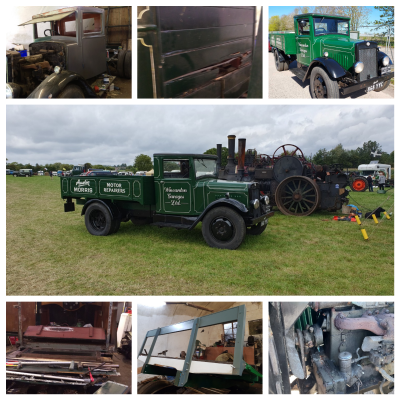
Work has included removal and refurbishment of the load bed, replacement of the back of the cab and front roof support, refitting windows, making new door panels, and much other mechanical work. The lorry has now been out, static and then running to a couple local shows. The next steps include replacing the exhaust system, refurbishing the carburettor and possibly a dynamo refurbishment. The lorry will also need some better tyres for long road use - it has been trailered so far. Steve's father was going to sell it 8-9 years ago, so Steve took it apart, so he couldn't!! He has known the lorry since birth, and has personally completed 90-95% of the work, himself, often without any previous knowledge. Its a rare vehicle and a proper survivor that will create much public interest out and about. It is thoroughly deserving therefore, of a restoration award.
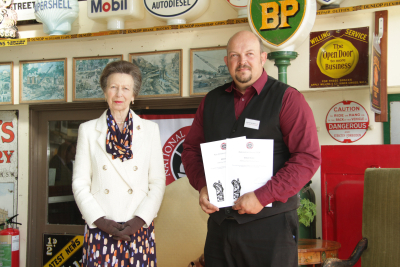
Restoration Awards
The Griffin Trust - 1960 CA Bedford Pick-up Truck
This restoration is being led by Mike Foulkes, part of The Griffin Trust based in Ellesmere Port, and is effectively a nut & bolt restoration to provide a working vehicle as well as a show addition to the collection of Bedford trucks. Once a common sight, this pickup was the Bedford equivalent of the Transit van. This version is now rare, most examples being of the Dormobile variety. As a bonus, it has a hand cranked tipping gear. Progress to date has seen a re-built tipping body, the chassis stripped, sandblasted & painted. The cab has been welded and is now being prepared for painting. All the mechanics are ongoing, and reassembly is beginning at last, with the help of a student from the local college and a team of volunteers, aiming for completion by mid-summer 2024.
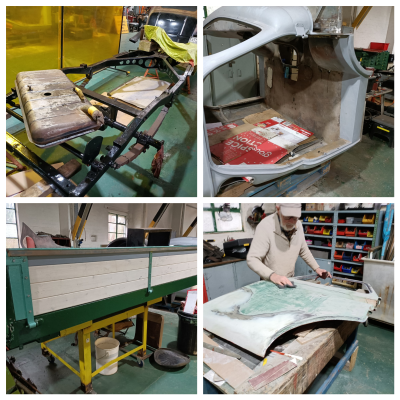
The Griffin Trust does terrific work preserving items from the Vauxhall and Bedford stables and has featured previously in awards line-ups.As well as the Vauxhall and Bedford products, it restores, houses and displays many other items of local interest, including aircraft. This is a nice little project to restore a once common, but now rather forgotten, model of a lost marque. The effort going into the restoration is most commendable and aims to return the vehicle to a fully operational condition, including the hand tipping gear. Not the sexiest of vehicles, but nevertheless worthy of an award.
Sywell Aviation Museum - The 1969 Handley Page Jetstream
This ambitious project, being undertaken by volunteers from the Sywell Aviation Museum, Northamptonshire, has seen the dismantling and reassembly of a rare Jetstream aircraft from Cranfield airfield at the Sywell Aviation Museum and work is now underway to restore the aircraft to be used as a classroom for the Museum's Young Aviator Tours. The HP137 Jetstream was HP's last design - a small turboprop airliner. Development began in 1965 and the first flew in 1967. This particular aircraft was assembled at Radlett during 1968, and first flown on 17th April 1969. Progress to date has seen the dismantling, transport and reassembly completed, and it is worth noting that if Sywell had not rescued it, then it would likely have been scrapped.

The tail plane has been refurbished and installed, and the elevators are refurbished and ready to re-fit. All passenger windows have been replaced and fitted, and the cockpit overhauled. SAM has taken 17,000 young people round the airfield from 2001 on its Young Aviator Tours, for which it won Northants Heritage Awards' Community Award in 2014 and Highly Commended for Best Special Project for the Jetstream Project in 2021. The whole point of the Jetstream is to use it as a classroom - since live aircraft are used on the tours the children cannot sit in them - and to permit children to work the controls etc. With airstairs and fitted seating it is a natural classroom. Hence, not only is it an important Sywell artefact, but in its own right it will enhance the visitor experience by permitting something not possible before, and also increase display space as part of its cabin will be seating, part will be display area. As a result the Trust is delighted to recognise the project with a restoration award.
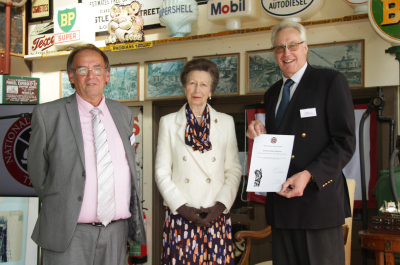
Richard Loudon - 1939 Leyland Cub FK8 Fire Engine
Owned by Richard Loudon, of Scunthorpe in Lincolnshire, and restored with the help of Barrie Seeley, this project sees the restoration of Richard's home town fire engine after it had been resting in a barn in Lincolnshire for almost 50 years. It is a classic open cab pump ladder which had a crew of two and up to a further six on the running boards. The ladder is actually older than this pump, but typical of the type carried, and they were interchangeable. It was new to Scunthorpe Borough Fire Brigade in August 1939, delivered one month before the outbreak of WW2. Richard served over 32 years as a firefighter at Scunthorpe Fire station retiring in 2007. This vehicle is one of only 2 pieces of Scunthorpe fire station equipment which are known to have survived. The workmanship on the visible parts is of a very high standard and the restorers have retained original material where possible, but lino and upholstery have been fully replaced, as has the wiring, a replacement fuel tank fitted and the engine fully overhauled. Mudguards have had plates welded in where rust was excessive and similar repairs have been made elsewhere to the bodywork. Paint is of a very high standard as is the signwriting, all the more impressive as work was undertaken largely by torchlight as the engine was stored in a part of the shed with very poor lighting. Being a seasoned fire-fighter, Richard claims that he knows who was responsible for every dent and scrape!
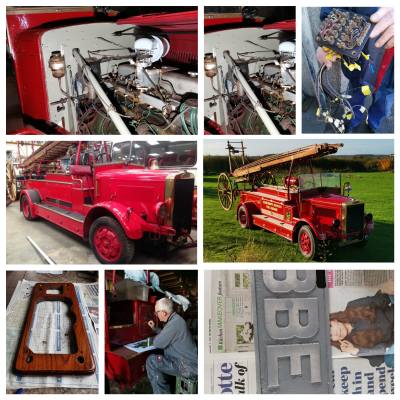
This fine old appliance has returned to its home town after more than 55 years absence. Other than the coach-painting and lining it has been completed by the owner and a friend both of whom are of state pension age. It is a brass finish appliance and as such requires constant attention to lots of brass work to keep it up to standard. To date 90% of the restoration has been completed, The vehicle has been serviced, new brakes, master cylinder and tyres have been fitted. It has been coach-painted and lined in 24 carat gold leaf. The signwriting has been carried out professionally and the vehicle rewired. Authentic replacement deck covering has been fitted to the top deck and locker tops and an electric water pump fitted to aid engine cooling. Planned next steps include final rewiring, main internal locker to be repainted and the escape ladder to be painted and varnished. Nonetheless it is a fine achievement and most worthy of a National Transport Trust restoration award.

Alistair McMurray - Loyd Carrier
Another Lincolnshire project is this super rare, wartime tracked carrier restored by Alastair McMurray of Lincoln This Loyd Carrier was designed by the Vivian Loyd company in 1939 and approved for production in 1940. It is an open topped, fully tracked utility, tank support and anti-tank gun towing vehicle, built in a number of different versions for these roles. The restoration is of a Ford-built towing version, recovered from an army firing range as a wreck. And what a wreck! The Loyd is a prime example of the British rush to build vehicles, any vehicles, in the dark days of1940. Loyds were issued to all military divisions for D-Day, and served through to VE Day across northwest Europe. This particular Loyd was sold to the Belgian Army post-war to help it re-arm. But as time went by, it ended up as a target on a firing range. Only one partly complete Loyd survives in a UK National Museum today. Having stripped the wreck down in 2010, Alistair began the task of locating from around the world, replacements for missing or damaged parts - the tracks for instance came from New Zealand.
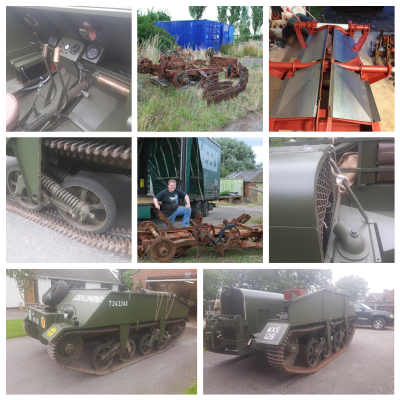
Firstly the rolling chassis was completed and then a new hull was drawn up from surviving sections. Alistair has compiled over 100 drawings for missing parts and these have been given freely to people around the world who are attempting other Loyd restorations. In 2023 it was driven for the first time. Like many modern restorations, progress has a strong social media following. The final step in the project is to have a canvas hood manufactured. Alastair found an original new stock hood in a private museum which he has been lucky enough to borrow in order for it to be copied and thus complete the project. The Loyd is a very rare survivor which all those taking part in the D-Day invasion through to VE-Day would have been familiar with. It represents the 1940s spirit to make do and mend and received input from so many now defunct British engineering firms. As such it is a fine recipient of a restoration award.

Richard Day -1910 Marshall No 2 Light Traction Engine
This project, undertaken by Richard Day of North Scarle near Lincoln, has involved the complete restoration from an incomplete, derelict wreck of a very rare engine, which spent its working life in Tasmania. Marshall Light Traction engines were made for export and were single speed engines, with a flywheel clutch, designed for direct traction ploughing and had unusual feed water heaters to raise overall thermal efficiency. This engine was the last one exported to Australia, from where it was then transferred to the Cheshunt Estate in Tasmania. It has all the available extras offered by Marshalls. It is a very rare, possibly unique, survivor in that it is a two speed engine with the second speed pinion taking the place of the clutch. The engine returned to the UK around 2007, but restoration did not start until 2016, and has been virtually continuous ever since.
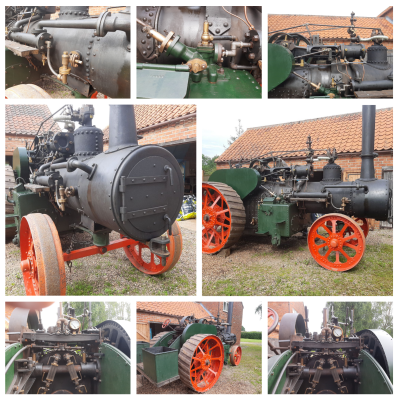
Everything apart from the boiler rebuild and pattern making has been done by the owner, including all the machining and fitting. Numerous sub-assemblies have been manufactured from Gainsborough Heritage drawings, including the complete rear man stand, winding drum support and drive, swivelling winch pulley and boiler fittings. The single cylinder engine had a broken trunk guide, so a new one was cast and professionally welded to the original bed plate. The engine is currently in final stages of reassembly. This is a unique traction engine that has been saved from the scrap man and brought back to life. Once complete, the intention is to work the engine to demonstrate threshing and chaff cutting and eventually, once Richard has made a suitable plough, direct traction ploughing. A worthy award winner.
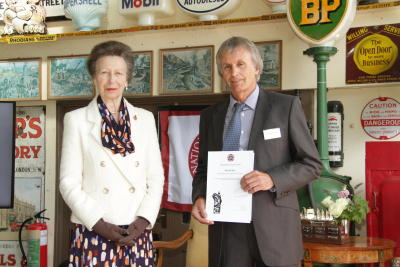
The Friends of 1760 - 1882 Aveling Steam Roller
There is a gang of determined people from Vale of Belvoir, near Melton Mowbray, who call themselves The Friends of 1760 They have performed something of a modern miracle restoring an engine to working condition that most experts said could never be restored, because the boiler is made from wrought iron. In straight age terms, 1760 is the second oldest surviving steam roller but, unlike the oldest, it is substantially original and unaltered. Once returned to steam it will be the oldest operating steam roller and may well be the oldest operable steam boiler on any road engine. For many years it sat in a corner of the Aveling Barford collection, intact, but inoperable as much repair was needed for the boiler, and seemingly no prospect of ever steaming due to the fickle nature of the original boiler material.
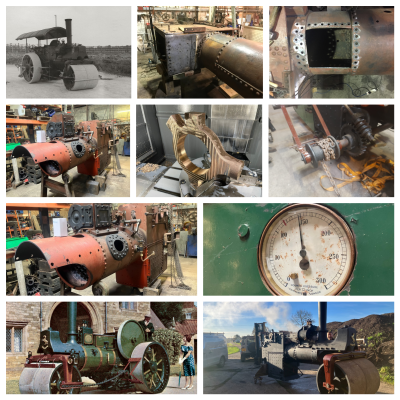
It then fell into the hands of Edd and team, who are no strangers to a challenge or two. It was first seen by the NTT adjudicator a number of years ago, sitting in a corner of the workshop where the same team were working on another early Aveling that would in itself win an award. Working with metallurgy experts, and with the very real prospect of the project shuddering to a halt over some insurmountable metallurgical problem at any point, by using extensive material analysis and testing, the team came up with a repair scheme that will see this unique early engine back in steam and fully certified. It is a credit to the determination and tenacity the team of restorers who have worked tirelessly to see the project through - knowing that at any point the whole project could stall. They have thrown every modern trick in the book at it, from ultrasonics to X ray, with constant testing of samples of material and welds. As a little easy side-line the team even manufactured a new mechanical pump as the old one was butchered during its last working years. This is a small engineering miracle. A unique and timeless reminder of the skills and drive of our forebears - an attitude it seems that is shared with the Friends of 1760. This is a very well deserved restoration award.
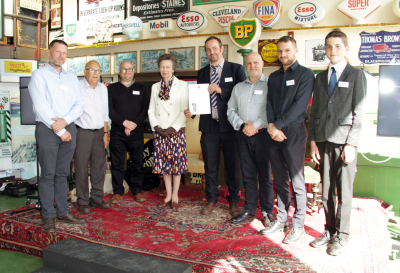
Turn To Starboard - The Spirit of Falmouth
This project is being completed by a group known as Turn to Starboard and involves the ongoing restoration and preservation of The Spirit of Falmouth. Originally built in late 1984 as Spirit of Merseyside, she is a replica of the Liverpool pilot schooner, Leader, used in the 19th century in the days of sail, to guide vessels into the port of Liverpool. Spirit is the last representative of her marque - none of her nine predecessors exist any longer. In 2014 she was donated to Turn to Starboard by The Princes Trust and renamed the Spirit of Falmouth and since then she has sailed over 1500 veterans, continuing to train and allow ex-service personnel to experience mindfulness and wellbeing, as well as helping to raise much needed funds while undertaking sponsors' voyages.
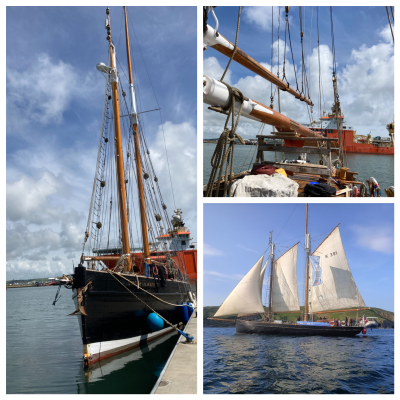
We all know from personal experience that time takes a toll, and vessels such as this are no exception. The masts have been surveyed in situ, the fore being condemned the aft requires removal for further examination. The sails have been assessed and reported to be beyond repair. The sails are now 40 years old and have reached the point that they can not be repaired further so the aim is to replace them. Without this preservation effort and investment, an important part of the nation's sailing heritage could end. Although a replica, she is older than many of the service veterans from groups like Blesma, The Chelsea Pensioners, Fighting for Pride, We Salute You and many more military organisations who sail with her, not just for training but for wellbeing experiences. The Turn to Starboard team continues to demonstrate that vessels such as this have a valuable national role, and the Trust considers it an honour to contribute by way of a restoration award.
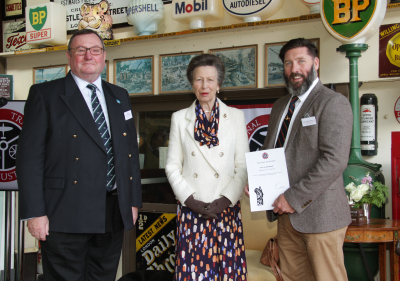
Chris Hutchinson - 1927 Sentinel Steam Waggon
In 2016 Chris Hutchinson, from Alloa, Clackmannanshire, purchased the remains of a Super Sentinel steam waggon engine from the estate of the late John Keeley. The project has been to to rebuild the waggon using the engine and integral transmission as its basis. As far as could be determined from what few records and photographs remained, the engine belonged to waggon number 6982. Although there are approximately 50 Super Sentinels in preservation, it is still a relatively small number compared with the total number manufactured. Engine number 6982 could have been broken for spares but it has now been re-built into an overall design representative of the period. The project was undertaken by the owner, his son, his six grandchildren, both boys and girls aged 12-19 years, and an engineer based some 430 miles from the project location. Emphasis has been on trying to pass on skills and experience to the younger team members and to get them actively involved from design through to manufacture or refurbishment of components.
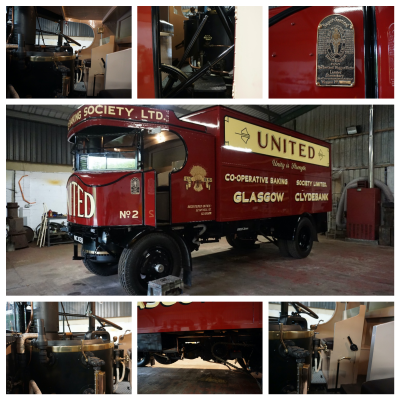
Every effort has been made to re-create the blued steel cladding as used on the original boilers. The lion's share of the work has been done using original Sentinel drawings. Fabrication of the front apron cheek plates were formed by hand to match the one original sample that had survived. Two of those involved have used the project for the skills element of their Duke of Edinburgh Gold awards. Their work embraced acquiring both old and new skills including machining, hot riveting, welding, wood working, timber steaming and coach painting to name a few. The waggon is now complete and roadworthy. It is registered for the road as an historic vehicle. The active involvement of young people and the absolutely outstanding finished product is most impressive and the attention to detail whilst making it safer and easier to operate are to be commended. It is a very worthy winner of a National Transport Trust restoration award.

James Loader - 1932 6 Ton Timber Carriage
James Loader, from Ringwood in Hampshire, is the proud owner and restorer of this fine timber carriage, made by Taskers of Andover, in 1932. Only a handful of these survive and anyone who knows anything of timber work will be amazed that, given the conditions and harsh working environment of their working lives in woodlands, any survived at all. This particular trailer is the telescopic model of which even fewer have survived to the present day. The project is an example of a fairly simple but now very rare trailer used for bringing felled trees out from their original site. It is telescopic, the chassis being capable of being extended in order to permit the carrying of longer trunks. The front axle and draw bar slews on a circular base without the use of bearings.
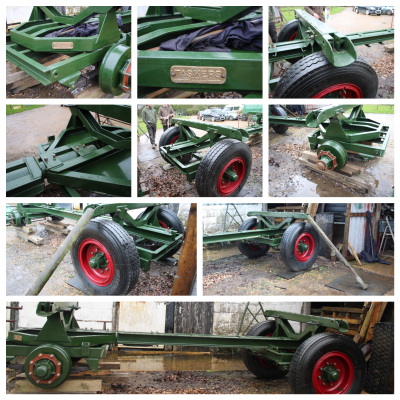
It is a niche agricultural/forestry product which might easily be overlooked but which had extensive use in rural parts of the country. Trunks to be loaded onto the trailer have to be rolled using a crane device up onto the chassis, utilising timber sections, butting onto channelled sockets above each axle, as rails. As ever with something like this, the original to do list was lengthy - chassis framework, axles, brakes, leaf springs and even nuts, bolts and fasteners have all required considerable attention. But clearly James is a bit of a stickler for detail; new old-stock British standard nuts and bolts have been sourced and used in the restoration throughout, an increasingly difficult and expensive task. This has enabled details such as the direction of bolts to be fitted in the same orientation. All parts have been cleaned and painted in the original colour scheme of Deep Bronze green. While this is a relatively simple and utilitarian piece of equipment, the care which has gone into preparing this relic of a now lost rural heritage for public viewing is very deserving of a restoration award.

The Sea Ranger Association - Waterwitch
Waterwitch is a wooden Morgan Giles rowing and sailing gig owned by the Sea Ranger Association, a registered charity based in Portsmouth run by volunteers. Waterwitch is believed to be the only one of her kind left - 6 were built for Sea Rangers but this will be the only one afloat. She has a range of provenance and may even have been rowed by the late Queen, although direct evidence of this is yet to be found. Being laid up throughout Covid and beyond did her no favours, and now every effort is being made to get her back in service ably assisted by a professional boatbuilder, Peter Collins, who is giving up his time freely to oversee the project.
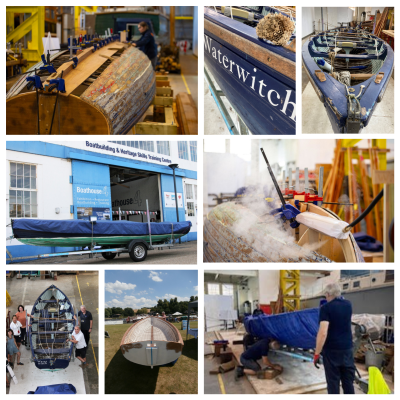
Once completed, she will return to providing training and experience to sea rangers enhancing an already impressive suite of outdoor activities including camping, rowing, kayaking and sailing - indeed anything on the water. With the training of young people in outdoor pursuits, the teamwork involved in crewing and coxing a boat such as this and the mental health benefits that the outdoor provides make such a project very worthwhile and the National Transport Trust is delighted to add its support by way of a restoration award.
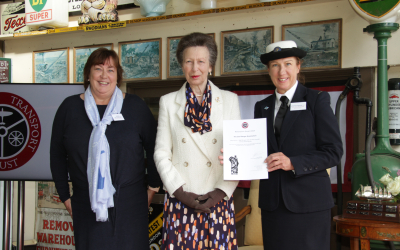
Toby Robinson - 1919 Thornycroft Lorry
In 1896, naval engineer John Thornycroft formed the Thornycroft Steam Carriage and Van Company and by 1919, Thornycroft was estsblished as a major manufacturer of, amongst other things, commercial vehicles. Over time, like many other great names, much of that has slipped away. This particular example of a Thornycroft lorry from 1919, owned and restored by Toby Robinson, from Newick in East Sussex, is a particularly rare example. 1 of only 3 low radiator J type Thornycrofts to survive, this one is the only civilian J type restored and currently running. Chassis number J7860 is recorded as being delivered in 1919 to a Mr Joseph Brierley of Warrington, Cheshire, local metal merchant and general haulier, who later found local fame for having numerous Supermarine Spitfires piled up in his yard prior to scrapping.
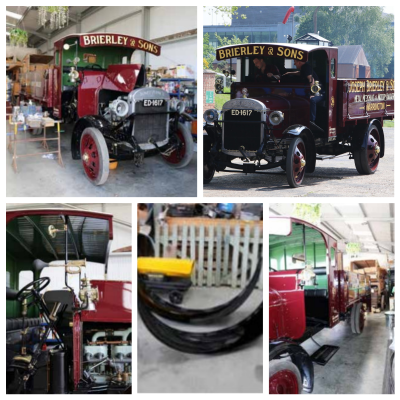
From here it was sold into preservation and underwent a couple of unauthentic rebuilds, appearing very sparsely at public events. Toby purchased the vehicle in 2019 with the view to restoring it to its authentic condition as it would have worked a hundred years earlier. Since then Toby, 21 at the time, has been obliged to learn a whole range of new skills including coach painting, signwriting, gilding, woodwork, metal work, riveting and pattern making. He also undertaken extensive research and has completed the required drawings and design documents to a very high standard. It has taken 4 years to deliver this very rare 1919 Thornycroft lorry, completed to a very high standard indeed. As a result the Trust is delighted to recognise Toby's efforts with a restoration award.
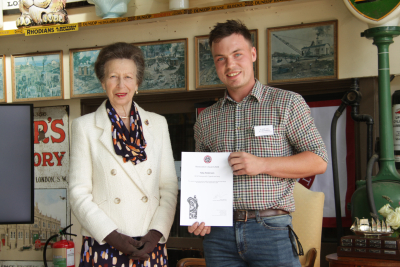
The National Transport Trust makes loans to groups, associations and individuals at advantageous rates for the restoration of artefacts - whether mobile or part of the infrastructure. Applications must be supported by a simple business plan which demonstrates the financial viability of the project. A sample business plan is available on request from the Treasurer.
The Trust does occasionaly make Awards for schemes which further the preservation movement. Again if you wish further information please contact the Treasurer.